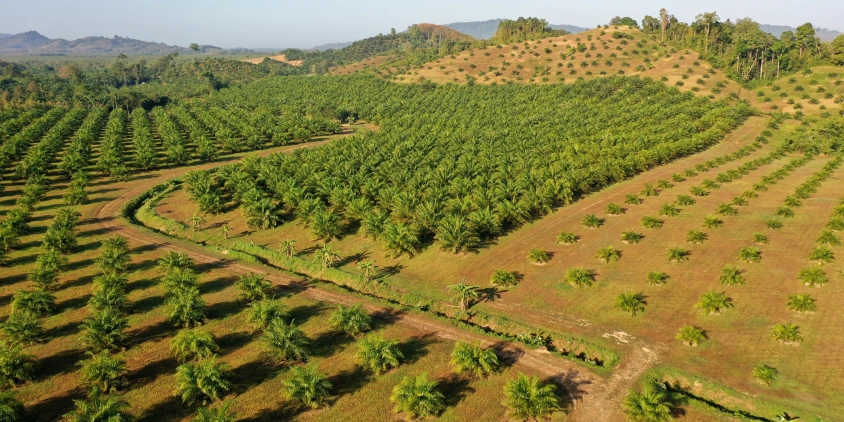
Oil Palm Farming In Southeast Asia: Sustainability Path
Palm oil, a versatile commodity found in countless products, has become a cornerstone of Southeast Asian economies. Now, Thailand, Indonesia, and Malaysia are leaders in palm oil production, transforming vast swathes of land into sprawling plantations. This agricultural revolution has brought economic prosperity but also significant environmental challenges. As the world grapples with climate change and biodiversity loss, these countries find themselves at a crossroads. Our article explores the complex landscape of oil palm cultivation in Indonesia, Malaysia, and Thailand, examining its economic impact, environmental consequences, and ongoing efforts to strike a balance between productivity and sustainability.
Basics Of Palm Oil Production In Southeast Asian Region
Palm oil production, as a major economic driver, is vital to the economies of both Indonesia and Malaysia. A whopping 85% of the global production comes from these two countries. Despite being the world’s third-largest producer, Thailand slightly affects global palm oil prices. Nevertheless, demand and, thus, production are anticipated to rise as Thailand’s economy begins to show signs of improvement, especially in the hospitality and tourism sectors.
Palm Oil Industry In Indonesia
The rapid expansion of industrial agriculture in Indonesia has led to a boom in palm cultivation. With a yearly output exceeding 50 million tons (45 million tonnes), today Indonesia dominates the global palm oil market . The islands of Sumatra and Kalimantan provide ideal environments for cultivation; thus, these are the primary growing areas. Rapid industry growth occurred in Indonesia as a result of the country’s welcoming policies toward agriculture, large tracts of arable land, and foreign investment. As the world’s demand increases, Indonesia’s grip on the market only tightens, cementing its status as the industry leader.
Palm Oil Industry In Malaysia
Malaysia’s ascent to becoming the world’s second-largest palm oil producer is a story of successful agricultural transformation resulting from strategic government initiatives, calculated moves to reduce economic dependence on rubber plantations, and optimal climate conditions. Producing about 20 million tons (18 million tonnes) annually, the country has effectively harnessed the tropical conditions of Peninsular Malaysia, Sabah, and Sarawak for large-scale cultivation . The outcome is a robust palm oil production in Malaysia that has significantly boosted the country’s agricultural exports and economic standing.
Palm Oil Industry In Thailand
Plantation operations and industry production have expanded rapidly across Thailand in response to the rising demand for palm oil in food, beauty products, and biodiesel. Government incentives for smallholders have greatly promoted the industry’s expansion. Since 2022, Thailand has produced over 20 million tons (18 million metric tonnes) per year, with the southern provinces providing the majority of the cultivation areas . However, there are growing concerns about the environmental impact of oil palm cultivation in Thailand, particularly in regions with less suitable land and climate conditions.
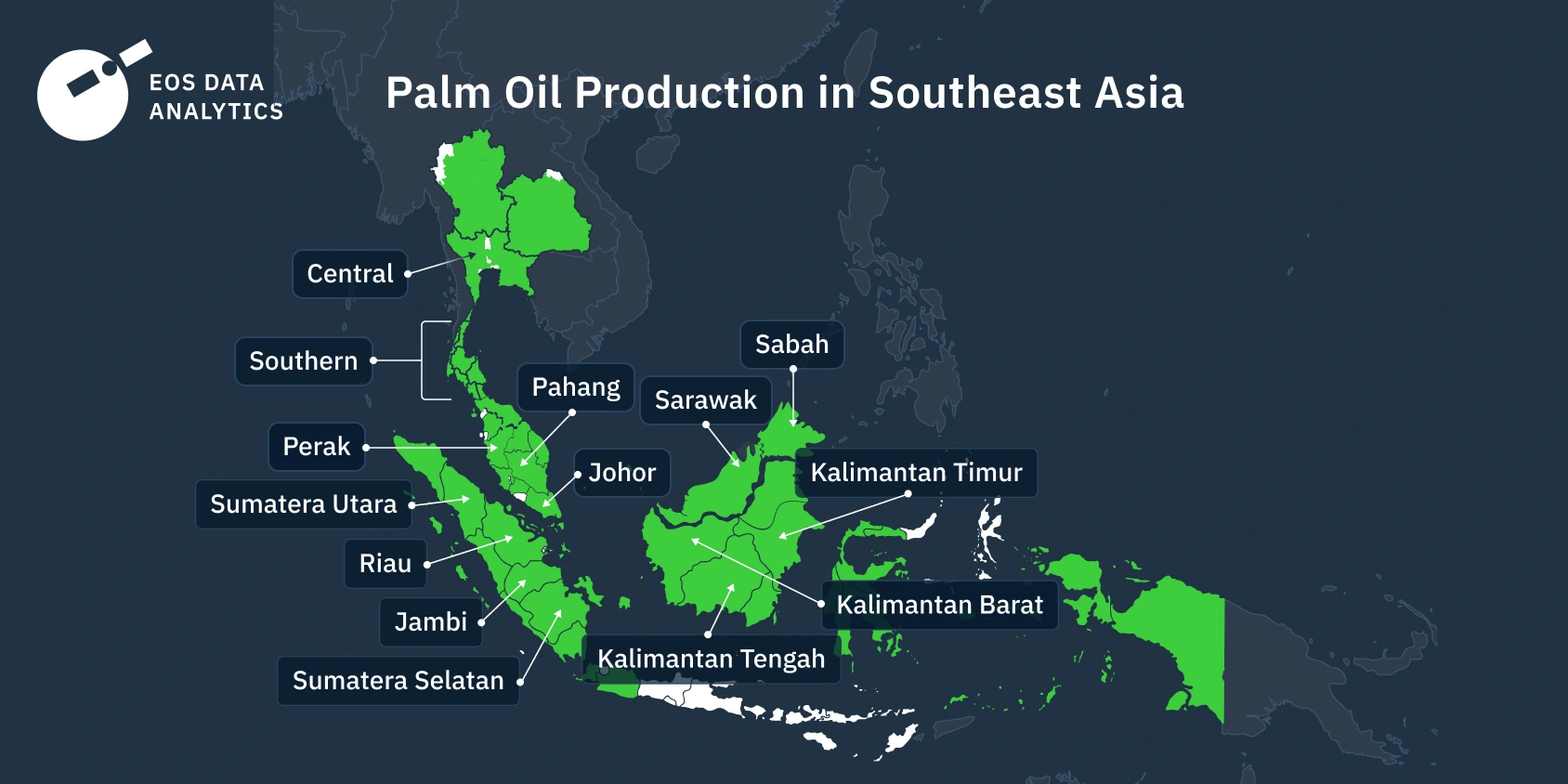
Environmental Impact Of Palm Oil Industry In Indonesia, Malaysia, And Thailand
The rapid expansion of the industry in Southeast Asia has come at a steep environmental cost. While this industry has brought economic benefits, it has also led to significant deforestation, devastating forest fires, harmful industrial waste, and extensive erosion.
Deforestation
Across Malaysia, Indonesia, and Thailand, ancient forests fall victim to the relentless plantations’ expansion. In our story of impact, we spotlight the findings of a journalistic investigation bolstered by cutting-edge satellite analysis from EOSDA scientists, exposing the dark truth of deforestation behind palm oil production in Malaysia.
According to the Center for International Forestry Research (CIFOR), in Indonesia, lately, oil palm plantations have been the main cause of deforestation, leading to enormous greenhouse gas emissions . In addition, plantations can only absorb 20% as much carbon dioxide from the air as rainforests. Things get even worse because a significant portion of oil palm plantations in Malaysia and Indonesia are grown on carbon-rich peatlands.
Forest Fires
Forest fires, often started by small farmers engaging in slash-and-burn agriculture and, occasionally, by large plantation owners, lead to a persistent ecological disaster in Indonesia. Oil palm plantation operations in Indonesia, Malaysia, and Thailand are directly responsible for about 20% of forest fires and indirectly contribute to the problem by making drained peat soils more combustible, which speeds up fire spread.
Water Quality Degradation
Among the many environmental problems caused by the industry’s massive output is palm oil mill effluent (POME). Palm oil mills in Malaysia, similar to other South Asian countries, generate about 2.75 tons (2.5 tonnes) of waste for every 1.1 tons (1 tonne) of the product they extract. Freshwater contamination from the direct discharge of this effluent threatens ecosystems and the people who live downstream. Despite the plethora of treatment methods proposed by scientists over the past 20 years, only a handful have achieved significant industrial adoption . Deforestation and monocropping exacerbate the degradation of water quality.
Soil Erosion
When forests are cut down to make way for plantations, and when those plantations are cultivated in unfavorable locations, soil erosion occurs. In Malaysia, where there is a shortage of arable land and plantations are often planted on steep slopes and abandoned lands, erosion rates in mature plantations range from 7 to 12.5 thousand pounds per acre (7.7 to 14 tonnes per ha) in a year . The industry’s financial and environmental burdens get worse because erosion-prone regions necessitate increased use of fertilizer and other inputs. All of these problems underscore how important it is to use sustainable farming methods to keep the soil in Malaysian and Indonesian oil palm plantations healthy.
EOSDA Crop Monitoring
Offering high-resolution satellite images for fields analytics to monitor crops health remotely!
Key Strategies For Sustainable Oil Palm Cultivation In Indonesia, Malaysia, And Thailand
The acute environmental challenges in Malaysia, Thailand, and Indonesia call for sustainable oil palm cultivation. Now, these countries are embracing a three-pronged approach to transform their industries: implementing rigorous certification standards, adopting zero-deforestation policies, and leveraging advanced precision agriculture tools, all of which promise a more sustainable future for the industry.
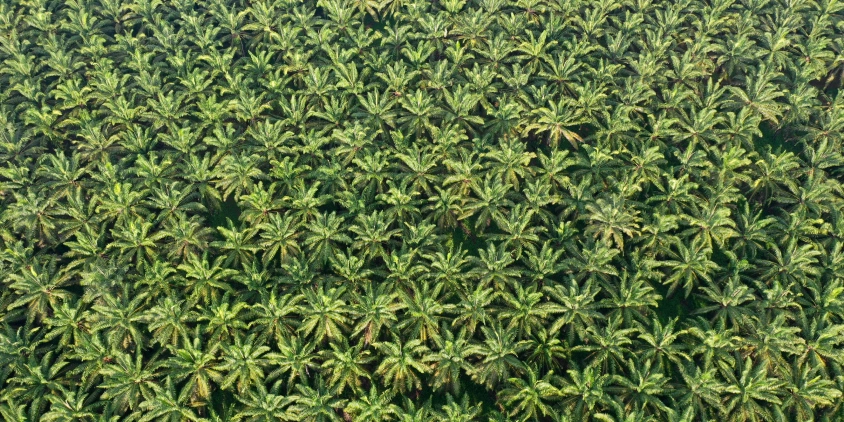
Rigorous National Certification Standards
Indonesia and Malaysia are moving toward sustainable palm oil production through rigorous certification standards. These national initiatives demonstrate a commitment to balancing economic growth with environmental stewardship and social responsibility. The key certification programs include:
- Indonesian Sustainable Palm Oil (ISPO), a mandatory government-led initiative ensuring legal, ecological, and social compliance;
- Malaysian Sustainable Palm Oil (MSPO), a compulsory certification covering responsible management, fair labor practices, and biodiversity conservation.
Zero Deforestation And Net Zero Emission Initiatives
Several anti-deforestation initiatives have emerged in response to the concerning deforestation tendencies in Southeast Asia. Malaysia and Indonesia are currently implementing the Asia Sustainable Palm Oil Links (ASPOL) program to eliminate deforestation from their industry supply chains. The industries of these two countries also committed to “No Deforestation, No Peat, and No Exploitation” (NDPE). As of April 2020, NDPE policies effectively cover nearly three quarters of Malaysia’s and Indonesia’s palm oil production, leaving ample room for improvement .
Until recently, there were hardly any national initiatives to stop deforestation or mitigate the environmental damage caused by palm oil production in Thailand. Nevertheless, in 2022, numerous producers, both big and small, came together to form the Thailand Sustainable Palm Oil Alliance .
To complement and strengthen these sustainability-oriented initiatives, EOSDA introduces its soil organic carbon (SOC) solution for eco-conscious crop producers in South Asian countries. This powerful modeling solution allows for the establishment of a SOC baseline and the continuous evaluation of SOC changes, which is essential for carbon credit claims and managing zero-deforestation projects. Governmental bodies can also harness our SOC modeling solution to assess the real-world impact of their environmental policies, fostering more effective and targeted interventions. Contact us at sales@eosda.com and discover how our solution can drive your sustainability goals forward.
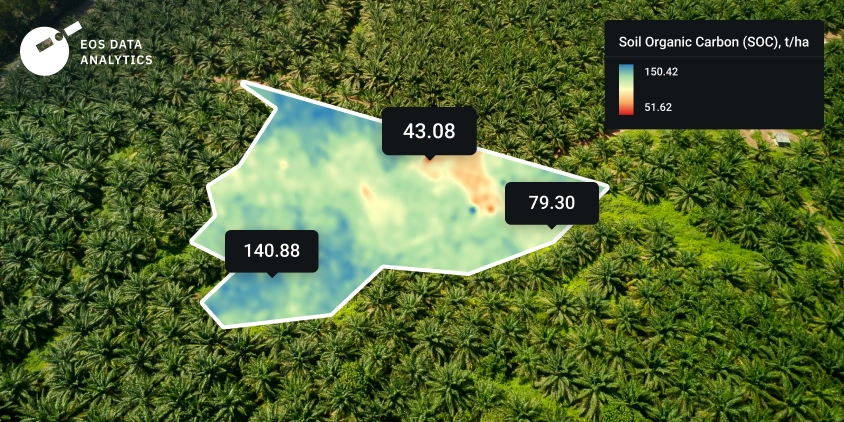
Optimizing Inputs And Increasing Yields Through Precision Agriculture
By defining distinct management zones within the plantation according to agronomic data, precision agriculture allows for optimal resource usage and an increase in plantation output without the need to expand acreage. For example, the NDMI maps available in EOSDA Crop Monitoring show the degree of water stress on the crop and identify the most demanding zones of the plantation. With the help of the NDMI and other water-related remote sensing data (soil moisture, historical weather, and forecasts) on the platform, you can implement better, more targeted water management.
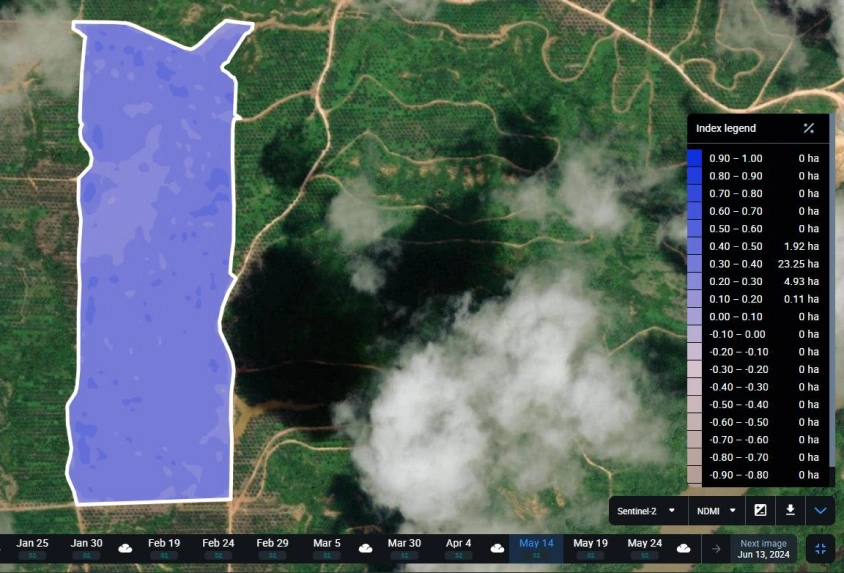
Effective disease control is a cornerstone of crop management, and precision agriculture tools are vital in this process. These tools provide timely information, allowing oil palm tree growers in Malaysia, Indonesia, and Thailand to stay ahead of potential disease development. With the Disease risk feature, which provides regular crop health monitoring, you can gain an advantage in safeguarding your fields. By being able to quickly pinpoint plantation areas that are highly susceptible to a particular disease, you can take immediate action to minimize crop losses.

Southeast Asia On Guard Of Global Food Security
The industry faces a critical juncture: meeting the growing global demand while minimizing environmental impact. Southeast Asian countries are at the forefront of this challenge. As the world population demands much more vegetable oils for food, oil palm plantations’ efficiency in Indonesia, Malaysia, and Thailand has become increasingly important. Switching to alternatives could require up to 10 times more land, devastating ecosystems and communities.
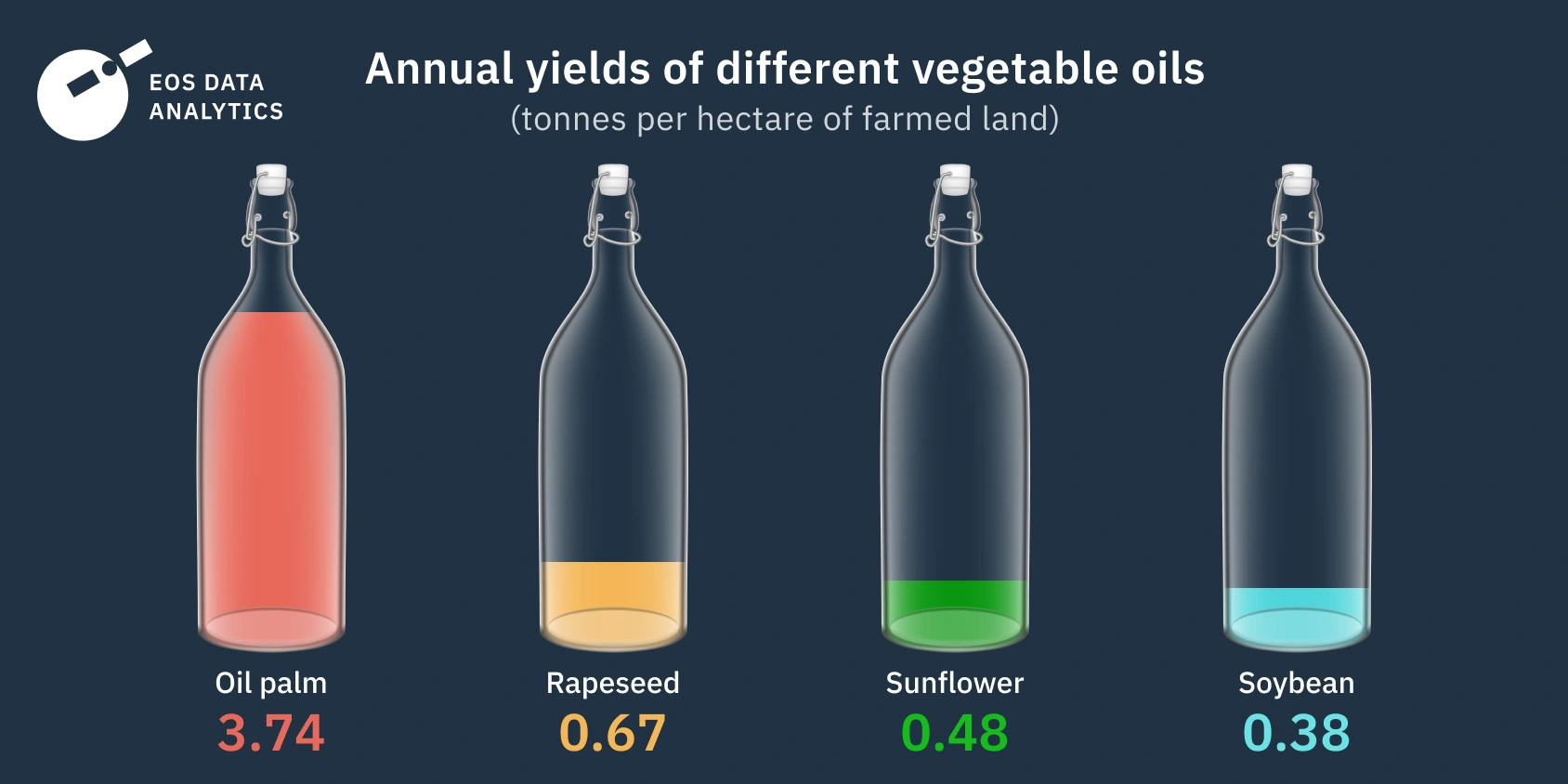
Our custom yield prediction solution offers a path forward by assisting plantation owners in forecasting yields so that they can make early adjustments for increased productivity of existing plantations, reducing pressure for expansion. New technologies, combined with stringent certification standards and legislation, robust environmental management, and active public engagement, can transform the industry. By embracing modern agricultural technologies and innovations, Southeast Asian countries can cultivate a sustainable palm oil sector that bolsters their economies while safeguarding the environment and social welfare.
About the author:
Vasyl Cherlinka is a Doctor of Biosciences specializing in pedology (soil science), with 30 years of experience in the field. He attended the engineering college in Ukraine and received his degree in agrochemistry, agronomy and soil science in the Chernivtsi National University. Since 2018, Dr. Cherlinka has been advising EOSDA on problems in soil science, agronomy, and agrochemistry.
Recent articles

Transition Guide From Sentinel Hub EO Browser To EOSDA LandViewer
Need an EO Browser alternative that’s just as familiar but more flexible? EOSDA LandViewer offers free recent imagery, a vast satellite data archive, and advanced analytical tools.
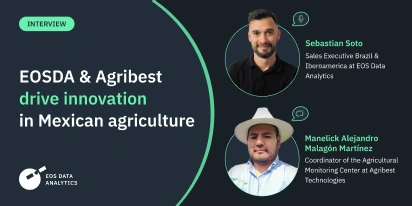
EOSDA & Agribest: Driving Agtech Growth In Mexico
In this insightful interview, Agribest shares how its collaboration with EOSDA is shaping Mexico’s agricultural future, with a focus on profitability, sustainability, and technology.

Top Ready-Made Agriculture Tools & Softwares for 2025
Agriculture softwares are silent partners in the field, working tirelessly behind the scenes to support farmers with insights and precision to cultivate sustainable agricultural ecosystems.